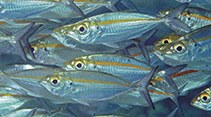| Family: |
Carangidae (Jacks and pompanos), subfamily: Caranginae |
| Max. size: |
25 cm FL (male/unsexed) |
| Environment: |
reef-associated; marine; depth range 35 - 500 m |
| Distribution: |
Pacific Ocean: Andaman Islands to Vanuatu, north to the Philippines, south to northern Australia. |
| Diagnosis: |
Dorsal spines (total): 9-9; Dorsal soft rays (total): 23-25; Anal spines: 3-3; Anal soft rays: 19-21. Description: Dorsal side blue-green to green, ventral side silvery to silver-gold; stripe, yellow from gill opening upper end to caudal peduncle upper part; spot, black on opercle edge. Eyes very large, shorter than snout length; adipose eyelid well developed. Body elongated and compressed moderately; profile, dorsal less convex than ventral. Cleithrum (lower margin of gill opening) with furrow, deep; large papilla immediately above and small papilla on upper edge. Breast fully scaled. LL curved part longer than straight part; LL scales only on curved part, none on straight part; LL scutes 43-46, large, strong. Pectoral fins falcate; anal fins first two spines detached. (Ref. 2334, 90102) |
| Biology: |
Adults are found inshore and form large schools on day time. They disperse at night to feed on planktonic and benthic invertebrates such as crabs and shrimps. Eggs are pelagic (Ref. 4233, 7300, 90102). |
| IUCN Red List Status: |
Least Concern (LC); Date assessed: 09 March 2015 Ref. (130435)
|
| Threat to humans: |
harmless |
| Country info: |
|
Source and more info: www.fishbase.org. For personal, classroom, and other internal use only. Not for publication.

